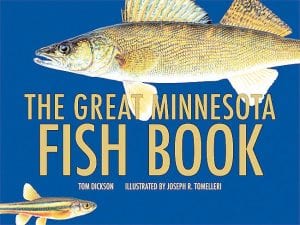Although the author of The
Great Minnesota Fish Book
no longer lives in Minnesota—author Tom Dickson now resides in Montana— the Minnesota native more than ably catalogs the diverse species that swim in Minnesota’s 10,000 lakes.
The introduction, appropriately entitled “The Opener” gives an idea of the flavor of the book. It includes interesting information about the watersheds of Minnesota and the fact that there are 161 different fish species in Minnesota. Dickson notes that 139 are native—and all of them are unique. His book provides intimate details on 105 species—game fish, rough fish, and little-known fish.
Twenty-seven of the species are game fish, which, according to Dickson receive the most attention from anglers and fisheries biologists. Indeed, the smallmouth bass, northern pike, walleye, and rainbow trout species will be very familiar to North Shore anglers. But the drawings by illustrator Joseph R. Tomelleri give fishermen the chance to see these fish—usually seen in the net or live-well—in intricate detail.
Each colorful illustration is accompanied by a wealth of information, such as the species name, a tidbit of history about the fish, where it can be found, some of the author’s fishing experiences and state record catches. The species names alone make the book fun to read—for example, the scientific name for lake trout is Salvelins namaycush.
Dickson explains the name—Salvelins:
a Latinized name for char, from the root of the German saibling,
meaning “a little salmon” and namaycush:
an English-language rendering of the Cree name for the species, namekos,
meaning “dweller of the deep.”
The historical tidbits are delightful—who knew that Zane Grey called the smallmouth bass “a great golden-bronze treasure” or that the brown trout was introduced to Minnesota sometime in the early 1920s from Germany or that steelhead have been surviving in Lake Superior since 1895.
The records offer up a little hometown pride for North Shore readers—more than a few have been made in Lake and Cook counties—the Northern Pike record is 45 pounds 12 ounces caught in Basswood Lake in Lake County; the walleye record is 17 pounds 8 ounces in Seagull River, Cook County in 1979 and the rainbow trout record is 16 pounds 6 ounces in Devil Track River in 1980.
The pages of rough fish are far less familiar but entertaining—the gangly longnose gar, the mottled brown bullhead, the shovelnose sturgeon. Even more out of the ordinary are the fish in the little known fish section—the horneyhead chub minnow, the sparkly pearl dace, the exotic banded darter and the prehistoric looking deepwater sculpin, which lives primarily in Lake Superior, but has been found in Lake Saganaga.
Among the little known fish are two that are well-known to anyone who resides near Lake Superior—the rainbow smelt, fondly remembered by those who took part in the smelt runs of the 1960s and 1970s and the sea lamprey which is remembered fearfully as the fish that nearly destroyed Lake Superior’s trout fishery.
Throughout the book, the reader can’t help but wonder—how did illustrator Tomelleri capture the colors, the fin shapes, the intricate details? His “Artist’s Note” explains the complicated process of collecting, measuring, photographing, dissecting and drawing. The note is a final interesting catch in a book that is as enjoyable as a day on the lake.



Loading Comments